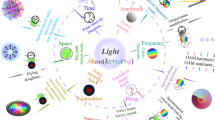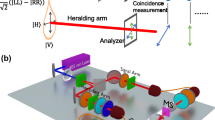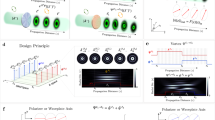Abstract
While making objects less visible (or invisible) to a human eye or a radar has captured people's imagination for centuries, current attempts towards realization of this long-awaited functionality range from various stealth technologies to recently proposed cloaking devices. A majority of proposed approaches share a number of common deficiencies such as design complexity, polarization effects, bandwidth, losses and the physical size or shape requirement complicating their implementation especially at optical frequencies. Here we demonstrate an alternative way to conceal macroscopic objects by structuring light itself. In our approach, the incident light is transformed into an optical vortex with a dark core that can be used to conceal macroscopic objects. Once such a beam passed around the object it is transformed back into its initial Gaussian shape with minimum amplitude and phase distortions. Therefore, we propose to use that dark core of the vortex beam to conceal an object that is macroscopic yet small enough to fit the dark (negligibly low intensity) region of the beam. The proposed concealing approach is polarization independent, easy to fabricate, lossless, operates at wavelengths ranging from 560 to 700 nm and can be used to hide macroscopic objects providing they are smaller than vortex core.
Similar content being viewed by others
Introduction
To date low-visibility devices rely either on shaping the object itself appropriately and/or covering it with radiation absorbing material (stealth approach) or on structuring optical space around the object with metamaterials to mold light around the object1,2,3,4,5,6,7,8,9,10,11,12,13. None of the implemented or proposed approaches to date realize complete invisibility. While the metamaterials-based cloaking approach is very promising, some of the inherent constrains of this approach at optical frequencies include narrow-band operation, losses and size limitations14,15,16,17. A possible alternative to structuring the “material” to mold light flow is to structure the light itself. Structured light already enabled such fascinating functionalities as the vortex coronagraph18,19,20, or optical traps and tweezers21,22,23,24. It is noteworthy that a vortex is a ubiquitous phenomenon that takes place in many different areas of physics from fluid dynamics, superconductivity, astrophysics to optics. It is well known that, for example, inside the eye of a typical hurricane, the wind is nearly vanished with blue sky above. Similarly, inside the eye of an optical vortex, the light intensity is nearly zero (although it is exactly zero only at a central singular point). Therefore, in this work, we propose to transform the incident light into a vortex beam with a dark core that can be used to conceal an object, followed by a reverse procedure that restores the beam back into to its original shape. We demonstrate that the object does not introduce significant perturbation either to the vortex amplitude or its phase and the incident beam amplitude and phase can be recovered.
Theory
In order to demonstrate the basic principle of the proposed approach, we built the simplest bi-directional setup consisting of two macroscopic spiral phase plates: the first plate is used to generate an optical vortex with a particular topological charge, a metal rod is placed “inside” the vortex dark core and another spiral phase plate is used to recover the original Gaussian beam from the vortex beam after its propagation around the hidden object. As shown in Fig. 1, the spiral phase plate is usually a transparent plate of refractive index n with its thickness increasing proportionally to the azimuthal angle around the central point of the plate, creating a spiral ramp with a step of a specific height (h) after one turn. A plane wave with wavelength λ passing through such a plate acquires a helical phase front with a phase singularity in the center. At the point of the phase singularity, the phase of the wave is undefined and the wave intensity vanishes resulting into a doughnut-like intensity profile. Such an optical beam is often referred to as an optical vortex with an orbital angular momentum (OAM) of a particular topological charge (determined by the height of the step of the spiral phase plate)25. The phase of the light beam carrying the OAM in the transverse plane is given by φ(r,ϕ) = exp(imϕ), m = (n − n0)h/λ, where φ is the angular coordinate; n0 is the refractive index of the surrounding medium and m is the topological charge, which can be any positive or negative integer number. The spiral phase plate not only transforms a non-helical (e.g., Gaussian) beam into a helical one, but can also be used to change the OAM of a helically phased beam. For instance, if an optical vortex with topological charge of −1, generated using a spiral phase plate with the step h, passes through the second spiral phase plate with the same step size but with an opposite helicity, the OAM would be cancelled and the vortex beam would be transformed back to the non-helical beam (See Supplementary).
First, we performed numerical simulations of the generation and reconstruction of the optical vortex beam using two spiral phase plates of opposite helicity. In our simulation, the spiral phase plates with refractive index of 1.5 are composed of 12 staircases with increasing height resulting in a step of twice the wavelength of the incident beam. The first phase plate transforms a plane wavefront into a helical one and transforms the expanded Gaussian beam intensity distribution into a doughnut one, as shown in Fig. 2. After the vortex beam passes through the second spiral phase plate, it is restored to the plane wave again, with minimal distortion. Since the singularity of the vortex beam has the same origin as an interference minimum, i.e. the energy is redistributed such that there is no energy present in the center, there will be no scattering from the hidden object and thus no shadow after it. Essentially the beam appears to pass through a totally empty space.
Experiments
To demonstrate the performance of the proposed approach experimentally, we use two spiral phase plates with opposite helicity made from PMMA to create the vortex beam and restore it back to the original beam. These two spiral phase plate were immersed in a refractive index matching fluid so that the imparted OAM is ±1. The OAM was tested by using a reference spherical wave interfered with the vortex lights produced by each of these two spiral phase plates separately26. Interferometric characterization results for these two plates confirming the opposite helicity are shown in Fig. 3(a). Figure 3(b) shows a metal rod with a length of 30 mm and a diameter of 0.7 mm, which was used as the obstacle to be hidden.
Results and Discussion
The laser beam from a He-Ne laser (λ = 633 nm) first passes through a spatial light filter and is then expanded into a plane-wave-like beam with a diameter of approximately 10 mm. The two spiral phase plates and a metal rod were aligned along the beam propagation as shown in Fig. 3(c). We experimentally studied the output in four different configurations: I) original beam; II) original beam incident on metal rod; III) original beam converted to vortex beam and incident on metal rod and IV) concealing device configuration. These measurements were repeated for different incident polarization states: linearly vertically polarized or horizontally polarized, as well as circularly polarized. The results of the device performance are shown in Fig. 4 column IV. The round spots in Column I show the input expanded Gaussian beam intensity profiles corresponding to different polarization states. Once the beam strikes the obstacle, a metal rod in this case, it would be scattered off the rod leaving a dark shadow in the center of the bright spots for all three cases polarization in Column II. Next, a spiral phase plate was added in front of the metal rod. As a result, a vortex beam, instead of a Gaussian beam, strikes the same obstacle. If the metal rod is aligned with the core of such a vortex, the beam cloaks the rod and passes around it with no significant perturbation, as shown in Column III. The dark hole is still visible in the center of the bright spot in Column III, however, this hole corresponds to the vortex core itself rather than light scattering from the obstacle as the beam twists around the metal rod without interacting with it. In this case, the concealing region has already been produced by transforming the incident Gaussian light into a vortex beam. As the final step, we need to demonstrate that the initial Gaussian beam amplitude and phase can be recovered from the vortex beam after it propagated around the object. In order to recover the initial Gaussian from a vortex beam, we inserted the second compensating spiral phase plate with exactly the same step size but with opposite helicity. Column IV shows the beam profiles after adding the second spiral phase plate. It can be seen that the dark hole in the center of each beam profile in Column III is largely filled with light in all cases shown in Column IV. These results prove that although the vortex beam rigorously speaking has an exact zero intensity point only at the middle singular point and a finite but very low intensity in the surrounding area within the vortex core, it can be used to conceal a macroscopic object because the vortex beam effectively wraps around the object reducing its visibility. We demonstrated that the object does not introduce significant perturbation either to the vortex amplitude or its phase and the incident beam amplitude and phase can be recovered. The residual shadow in the center is attributed to the fact that the two spiral phase plates with opposite helicity are not of exactly the same shape due to the fabrication imperfection. The performance of the device could be potentially improved if a vortex with larger OAM and correspondingly larger dark core is used. The small line perturbation on the left side of the beam is due to the imperfection of the phase plate itself.
Experimental results (output beam spot and corresponding intensity distribution profile cross sections, extracted by ImageJ) for different polarizations and different experimental setups: (I) original beam; (II) original beam incident on metal rod; (III) original beam converted to vortex beam and incident on metal rod and (IV) concealing device configuration.
These results aim to prove that we were able to recover the original Gaussian beam after vortex beam propagation around the macroscopic object. Importantly, these results also show that the proposed concealing device is polarization independent. Also, we theoretically investigated the useful bandwidth of the proposed design and found that the working band ranges from 560 nm to 700 nm (See Supplementary IV). Finally, in this paper we realized the simplest bi-directional implementation of the proposed concealing device in order to illustrate the basic concept. An obvious important remaining issue is related to the fact that in practice omnidirectional performance would be desirable. The proposed design opens a new route to concealing macroscopic objects using the structure of light beam itself. The proposed approach is macroscopic, lossless and polarization independent. A more elegant implementation could perhaps be realized using the metasurface-based approach recently proposed in27,28, assuming that the losses common to all metamaterials based devices could be minimized.
Methods
Materials
PMMA bulk samples with refractive index of 1.4872 and refraction index matching fluid with refractive index n0 = 1.4878 were used to fabricate spiral phase plates.
Fabrications
Two spiral phase plates with the diameter of 22 mm with opposite helicity were fabricated using a standard machine tool (Handan Exotic Device Ltd. China). A milling tool was used to cut a spiral ramp surface on the PMMA bulk by removing material around the axis circle by circle, from the center to the edge. Each circle cutting was done in 72 steps and then, resulted in a step size of h = 1.06 mm over a full turn. Two such PMMA samples with identical ramp size but opposite helicity were prepared. Finally, the spiral PMMA samples were immersed in the refraction index matching fluid to produce a vortex with charge ±1 due to the certain refraction index difference and the step size h = ±1.06 mm (see Supplementary information for details on fabrications).
References
Iwaszczuk Strikwerda, A. C., Fan, K., Zhang, X., Averitt, R. D. & Jepsen, P. U. Flexible metamaterial absorbers for stealth applications at terahertz frequencies. Opt. Express 20, 635–643 (2012).
Kirkland, K. 2007 Light and optics. (New York: Facts on File, Inc.).
Pendry, J. B., Schurig, D. & Smith, D. R. Controlling Electromagnetic Fields. Science 312, 1780–1782 (2006).
Leonhardt, U. Optical conformal mapping. Science 312, 1777–1780 (2006).
Schurig, D. et al. Metamaterial electromagnetic cloak at microwave frequencies. Science 314, 977–980 (2006).
Cummer, S. A., Popa, B.-I., Schurig, D. & Smith, D. R. Full-wave simulations of electromagnetic cloaking structures. Phys. Rev. E 74, 036621 (2006).
You, Y., Kattawar, G. W., Zhai, P. W. & Yang, P. Invisibility cloaks for irregular particles using coordinate transformations. Opt. Express 16, 6134–6145 (2008).
Li, J. & Pendry, J. B. Hiding under the carpet: a new strategy for cloaking. Phys. Rev. Lett. 101, 203901 (2008).
Leonhardt, U. & Philbin, T. G. Transformation optics and the geometry of light. Prog. Opt. 53, 69–152 (2009).
Cai, W., Chettiar, U. K., Kildishev, A. V. & Shalaev, V. M. Optical cloaking with metamaterials. Nat. Photon. 1, 224–227 (2007).
Valentine, J., Li, J. S., Zentgraf, T., Bartal, G. & Zhang, X. An optical cloak made of dielectrics. Nat. Mater. 8, 568–571 (2009).
Ergin, T., Stenger, N., Brenner, P., Pendry, J. B. & Wegener, M. Three-dimensional invisibility cloak at optical wavelengths. Science 328, 337–339 (2010).
Liu, R. et al. Broadband ground-plane cloak. Science 323, 366–369 (2009).
Chen, H. & Zheng, B. Broadband polygonal invisibility cloak for visible light. Sci. Rep. 2, 255; 10.1038/srep00255 (2012).
Tretyakov, S., Alitalo, P., Luukkonen, O. & Simovski, C. Broadband electromagnetic cloaking of long cylindrical objects. Phys. Rev. Lett. 103, 103905 (2009).
Ma, H. & Cui, T. J. Three-dimensional broadband ground-plane cloak made of metamaterials. Nature Commun. 1, 124 (2010).
Chen, X. et al. Macroscopic invisible cloaking of visible light. Nat. Commun. 2, 176 (2011).
Lee, J. H., Foo, G., Johnson, E. G. & Swartzlander, G. A., Jr Experimental verification of an optical vortex coronagraph. Phys. Rev. Lett. 97, 053901 (2006).
Foo, G., Palacios, D. M. & Swartzlander, G. A., Jr Optical vortex coronagraph. Opt. Lett. 30, 3308–3310 (2005).
Swartzlander, G. A., Jr Peering into darkness with a vortex spatial filter. Opt. Lett. 26, 497–499 (2001).
Gahagan, K. T. & Swartzlander, G. A., Jr Optical vortex trapping of particles. Opt. Lett. 21, 827–829 (1996).
Simpson, N. B., Allen, L. & Padgett, M. J. Optical tweezers and optical spanners with Laguerre-Gaussian modes. J. Mod. Opt. 43, 2485–2491 (1996).
Curtis, J. E. & Grier, D. G. Structure of optical vortices. Phys. Rev. Lett. 90, 133901 (2003).
Grier, D. G. A revolution in optical manipulation. Nature 424, 21–27 (2006).
Beijersbergen, M. W., Coerwinkel, R. P. C., Kristensen, M. & Woerdman, J. P. Helical-wavefront laser beams produced with a spiral phaseplate. Opt. Commun. 112, 321–327 (1994).
Padgett, M. J., Courtial, J. E. & Allen, L. Light's orbital angular momentum. Phys. Today 57, 35–40 (2004).
Yu, N. et al. Propagation with Phase Discontinuities: Generalized Laws of Reflection and Refraction. Science 334, 333–337 (2011).
Huang, L. et al. Dispersionless phase discontinuities for controlling light propagation. Nano Lett. 12, 5750–5755 (2012).
Acknowledgements
This work was supported by US ARO under award # W911NF-11-1-0333.
Author information
Authors and Affiliations
Contributions
J.S. and N.M.L. jointly developed the concept of using structured light for concealing macroscopic objects and investigated physical phenomena enabling the proposed device, its advantages and limitations. J.S. developed and optimized the design of the concealing device using two spiral phase plates and analyzed its performance using numerical simulations. J.S., J.Z. and X.W. built the experimental setup and performed optical characterization of the cloak. A.N.C. evaluated the experimental data and N.L. supervised the work.
Ethics declarations
Competing interests
The authors declare no competing financial interests.
Electronic supplementary material
Supplementary Information
Concealing with Structured Light Supplementary Information
Rights and permissions
This work is licensed under a Creative Commons Attribution-NonCommercial-NoDerivs 3.0 Unported License. To view a copy of this license, visit http://creativecommons.org/licenses/by-nc-nd/3.0/
About this article
Cite this article
Sun, J., Zeng, J., Wang, X. et al. Concealing with Structured Light. Sci Rep 4, 4093 (2014). https://doi.org/10.1038/srep04093
Received:
Accepted:
Published:
DOI: https://doi.org/10.1038/srep04093
This article is cited by
-
Phyllotaxis-inspired nanosieves with multiplexed orbital angular momentum
eLight (2021)
-
Spiraling Light with Magnetic Metamaterial Quarter-Wave Turbines
Scientific Reports (2017)
-
Hollow Gaussian beam generation through nonlinear interaction of photons with orbital angular momentum
Scientific Reports (2016)
-
Creation of an anti-imaging system using binary optics
Scientific Reports (2016)
-
Invisibility cloak with image projection capability
Scientific Reports (2016)
Comments
By submitting a comment you agree to abide by our Terms and Community Guidelines. If you find something abusive or that does not comply with our terms or guidelines please flag it as inappropriate.







